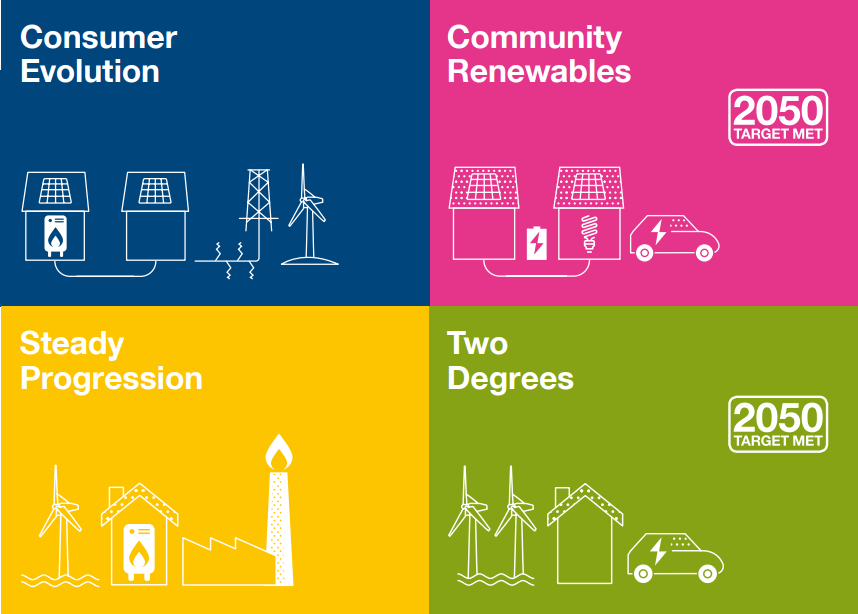
Renewable energy meets 80% of UK electricity demand by 2030
In July 2019, British power system operator National Grid released a report on the outlook for the UK’s energy development in 2050. There are four forecast scenarios set in this report called Future Energy Scenarios 2019 (hereinafter referred to as “ESO2019”). In understanding the process of modern energy development, this study may give us some inspiration.
Four simulation scenarios
ESO2019 first simulated a carbon-neutral energy development path, which coincided with the development strategy recently approved by the United Kingdom. The report believes that achieving clean and zero emissions in the energy sector is feasible, but this requires immediate action in the policy and technology areas. For example, new low-carbon heating systems should be installed in 2,300 homes by 2050.
Among the four scenarios described in ESO2019, according to the “Community Renewables (Distributed Renewables Development Scenarios)” and “2°C Development Scenarios”, UK carbon emissions can be reduced by at least 80% by 2050 , The national climate target can also be achieved, but according to the “stable development scenario” and “consumer evolution scenario”, the above-mentioned carbon reduction and climate targets cannot be achieved.

In all of the above scenarios, UK electricity production, especially carbon-free energy generation, will increase significantly. Especially in the “Community Renewable Energy Development Scenario” and “2°C Development Scenario”, the installed capacity of carbon-free energy generation will more than double by 2050. Among them, in the “community renewable energy development scenario” that emphasizes the development of local distributed renewable energy, the installed capacity of distributed renewable energy will reach 136 GW, accounting for 58% of the total installed power system. In the “2°C Development Scenario”, the increase in installed capacity of solar and wind power by 2030 will drive the share of renewable energy in the power generation structure to about 80%. When talking about how to ensure the best operation and flexibility of power systems with a high percentage of renewable energy installed capacity, ESO2019 mentioned several different methods, such as power demand management for residential, commercial and industrial users, V2G and V2H technologies related to electric vehicles, and energy storage.
In all forecast scenarios, the UK’s installed energy storage capacity will grow rapidly, especially in the “Community Renewable Energy Development Scenario”. Commercial and industrial users’ power demand management will also increase, after all, market rules and products will become more efficient in the future.
Forecasting of housing and transportation
In the residential sector, according to the forecast of the “community renewable energy development scenario”, the power system can achieve higher flexibility. With the high-level application of smart meters, smart appliances, and energy storage systems, the peak electricity demand for residential buildings in the UK will be reduced by 10% by 2030 and by 13.5% by 2050. Of course, whether the residential sector / power system can achieve high flexibility also depends on many factors, including the speed of popularization of dynamic electricity prices, the affordability of smart meters, and the number of energy storage system installations.
In the field of transportation, ESO2019 believes that the number of British electric vehicles will reach 35 million by 2050.

At the same time, up to 78% of electric vehicle owners will use smart charging stations and 14% of electric vehicle owners will participate in V2G technology applications. Thanks to this, electric vehicle systems will play an effective energy storage role, equivalent to five One-third.
Britain’s demand for natural gas will decline in all forecast scenarios, but demand for gas fuel will not decrease. Hydrogen will replace natural gas. The demand forecast for hydrogen fuel is the highest in the “2°C development scenario”. In addition, in all forecast scenarios, nuclear power will retain a certain share in the UK’s electricity structure, and will account for the largest proportion in the “2°C development scenario”.
In July 2019, British power system operator National Grid released a report on the outlook for the UK’s energy development in 2050. There are four forecast scenarios set in this report called Future Energy Scenarios 2019 (hereinafter referred to as “ESO2019”). In understanding the process of modern energy development, this study may give us some inspiration.
Four simulation scenarios
ESO2019 first simulated a carbon-neutral energy development path, which coincided with the development strategy recently approved by the United Kingdom. The report believes that achieving clean and zero emissions in the energy sector is feasible, but this requires immediate action in the policy and technology areas. For example, new low-carbon heating systems should be installed in 2,300 homes by 2050.
Among the four scenarios described in ESO2019, according to the “Community Renewables (Distributed Renewables Development Scenarios)” and “2°C Development Scenarios”, UK carbon emissions can be reduced by at least 80% by 2050 , The national climate target can also be achieved, but according to the “stable development scenario” and “consumer evolution scenario”, the above-mentioned carbon reduction and climate targets cannot be achieved.

In all of the above scenarios, UK electricity production, especially carbon-free energy generation, will increase significantly. Especially in the “Community Renewable Energy Development Scenario” and “2°C Development Scenario”, the installed capacity of carbon-free energy generation will more than double by 2050. Among them, in the “community renewable energy development scenario” that emphasizes the development of local distributed renewable energy, the installed capacity of distributed renewable energy will reach 136 GW, accounting for 58% of the total installed power system. In the “2°C Development Scenario”, the increase in installed capacity of solar and wind power by 2030 will drive the share of renewable energy in the power generation structure to about 80%. When talking about how to ensure the best operation and flexibility of power systems with a high percentage of renewable energy installed capacity, ESO2019 mentioned several different methods, such as power demand management for residential, commercial and industrial users, V2G and V2H technologies related to electric vehicles, and energy storage.
In all forecast scenarios, the UK’s installed energy storage capacity will grow rapidly, especially in the “Community Renewable Energy Development Scenario”. Commercial and industrial users’ power demand management will also increase, after all, market rules and products will become more efficient in the future.
Forecasting of housing and transportation
In the residential sector, according to the forecast of the “community renewable energy development scenario”, the power system can achieve higher flexibility. With the high-level application of smart meters, smart appliances, and energy storage systems, the peak electricity demand for residential buildings in the UK will be reduced by 10% by 2030 and by 13.5% by 2050. Of course, whether the residential sector / power system can achieve high flexibility also depends on many factors, including the speed of popularization of dynamic electricity prices, the affordability of smart meters, and the number of energy storage system installations.
In the field of transportation, ESO2019 believes that the number of British electric vehicles will reach 35 million by 2050.

At the same time, up to 78% of electric vehicle owners will use smart charging stations and 14% of electric vehicle owners will participate in V2G technology applications. Thanks to this, electric vehicle systems will play an effective energy storage role, equivalent to five One-third.
Britain’s demand for natural gas will decline in all forecast scenarios, but demand for gas fuel will not decrease. Hydrogen will replace natural gas. The demand forecast for hydrogen fuel is the highest in the “2°C development scenario”. In addition, in all forecast scenarios, nuclear power will retain a certain share in the UK’s electricity structure, and will account for the largest proportion in the “2°C development scenario”.




